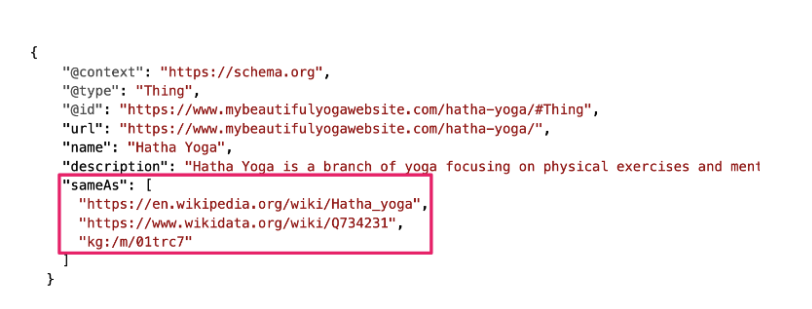Stop thinking about keywords. Start thinking about topics. This is what search engines are all about.
We’ll dig a bit deeper into this idea, but before that, to properly understand this concept, let’s start with how the PageRank works nowadays.
The evolution of PageRank
The initial PageRank has evolved over the years into a topic-sensitive PageRank, introduced in 2012 by a software engineer at that time, Taher Haveliwala.
In a few words, the topic-sensitive PageRank gives more value to the links set between semantically aligned pages.
This is how the actual PageRank works and we can see it involves two factors: topics and semantics.
From strings to things
Keeping that in mind when shifting from a keyword-based analysis to a topic-based analysis, or in other words, from strings to things, we’re able to see the big picture and eventually cover a topic holistically.
As an example, when analyzing the semantic corpus of the yoga topic, we find terms such as “mental health”, “carpal tunnel syndrome”, and “high blood pressure” (see below).

Source: YourText.Guru
Are they terms we would find when searching for keywords related to yoga? Not sure…
Are they terms that hold a semantic relationship with the yoga topic? Yes, they are.
Therefore, creating pages based on terms that come from a topic analysis rather than a keyword analysis allows you to create pages that are semantically aligned. It’s important to keep that in mind when drafting a content strategy.
But this is not enough…
Entity SEO
We’ve seen that search engines have evolved over the years from strings to things; meaning they’re now able to understand the context, meaning, and intent behind a query, to serve valuable results to users, and so rank pages accordingly.
With the introduction of AI into search engines, such as the Google AI Overviews, this becomes even more important to provide them with relevant and structured pages, so that they get a deep understanding of the meaning of the content, and eventually grant more authority and more visibility over the SERPs.
This is where entities come into play!
An entity denotes a singular, unique, well-defined, and distinguishable thing or idea. An entity can be a person, an item, an organization, a place, a concept, etc.
Nelson Mandela is an entity, London is an entity, apple is an entity, philosophy is an entity, yoga is an entity.
A semantic approach
So, let’s get back to our yoga example. When analyzing its semantic corpus in order to produce pages that are semantically aligned, we would likely find the term “Hatha yoga” (a specific yoga practice). This can easily become a page you could create while covering the yoga topic. On the other hand, “Hatha yoga” is also an entity, as you can see below.

Therefore, it could be more effective to focus on this specific entity on our page and mark it up to enhance the semantic understanding and interconnectedness of the content, and provide a clear unambiguous reference to the concept.
We can use the sameAs property to provide this clear, unambiguous reference to the entity, and to indicate that the subject of our page is equivalent to or closely related to the Hatha yoga Wikipedia page, Hatha yoga Wikidata item, and Google’s Knowledge Graph about Hatha yoga. See below:

Linking to knowledge bases such as the Wikipedia page and Google’s Knowledge Graph for a readable overview, and the Wikidata item for structured data, enhances the content’s semantic depth, aiding in disambiguation and providing a richer data connection for search engines.
Through the sameAs property, we could also link to other authoritative sources, such as:
- Educational resources
- Official website
- News articles
- Books
- Publications
- Social media profiles
Moreover, we can use additional schema markups to link to the concept, such as:
- Article or BlogPosting: if the content is meant to be a blog page.
- ExercisePlan: if the content is about a specific exercise plan or routine that includes Hatha yoga.
- HealthAndBeautyBusiness or SportsActivityLocation: if you want to mark up a business or location that offers Hatha yoga classes.
- Event: if you host Hatha yoga classes, workshops, or retreats.
- Person: to highlight instructors or founders associated with Hatha yoga.
- Organization: for pages representing businesses or organizations, like yoga studios or centers.
- CreativeWork: for content like articles, books, or instructional videos about Hatha yoga.
[Ebook] Mastering Structured Data
The semantic triple
Going through a schema markup strategy and connecting entities in a content strategy, or over a whole website, allows you to create an interconnected graph over a framework known as the RDF Triple (“Subject – Predicate – Object” statements) that helps search engines understand the relationships between entities.
To illustrate the RDF Triple framework while sticking to our yoga topic, we could create a page about Mark Singleton, a yoga teacher who specializes in Hatha yoga. The Mark Singleton entity shows up when analyzing the Hatha yoga semantic corpus; once again, we don’t mention keyword-based analysis here.
- Mark Singleton would be the Subject
- knowsAbout (property) would be the Predicate
- Hatha yoga would be the Object
Mark Singleton and Hatha yoga are both entities and they are related to each other.
On the other hand, if we decided to create a page about the topic of Hatha yoga, pointing to it from the Mark Singleton page through the sameAs property wouldn’t be a bad idea. Here’s a sample of how this would look:

BONUS: both page’s topics come from the same semantic corpus, making them semantically close to each other, or in other words, semantically aligned. Linking one to another through internal linking would please the topic-sensitive PageRank.
Wrapping up
That is a quick example of how to combine semantics and entities in SEO, but I guess you get the point: this is the way you move from a lexical approach + unstructured content to a semantic approach + structured content.
By doing so, you design an internal knowledge graph that provides structure and context to search engines, maximizing your chances of being considered a trustworthy resource for the topic you aim to get visibility for.


